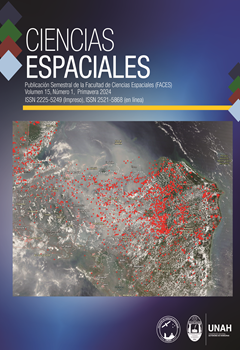Análisis correlacional de puntos de calor (incendios) y sus efectos en la calidad del aire, Honduras (2020)
DOI:
https://doi.org/10.5377/ce.v15i1.18148Palabras clave:
Calidad del aire, Puntos de calor, Gases de efecto de invernadero, Sensores remotos, CorrelaciónResumen
En la actualidad hay una gran cantidad de información geoespacial disponible de forma gratuita sobre emisiones de Gases de Efecto Invernadero (GEI) y puntos de calor. Este estudio buscó en 2020 establecer una correlación entre puntos de calor y su efecto en la calidad del aire hondureño. Las tecnologías geoespaciales facilitaron la adquisición, descarga y análisis de datos de contaminación y detección de puntos de calor. Los incendios aumentan los gases atmosféricos perjudiciales, el análisis encontró que los departamentos de Olancho, Francisco Morazán y Gracias a Dios son los más afectados por puntos de calor (incendios). Además, Yoro, Córtes, Atlántida, el norte de Francisco Morazán y Comayagua, y el noroeste de Olancho como los que presentan mayores variaciones en los niveles de afectación en la calidad del aire de los cuatro gases analizados el monóxido de carbono, dióxido de nitrógeno, dióxido de azufre y Aerosoles.
Descargas
356
Descargas
Publicado
Cómo citar
Número
Sección
Licencia
Derechos de autor 2024 Ciencias Espaciales

Esta obra está bajo una licencia internacional Creative Commons Atribución-NoComercial-SinDerivadas 4.0.




